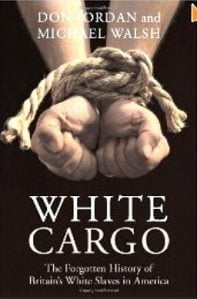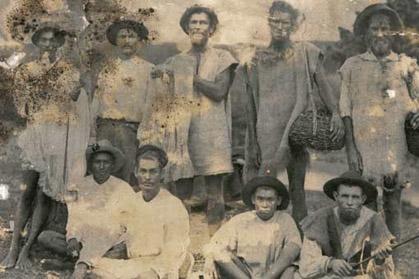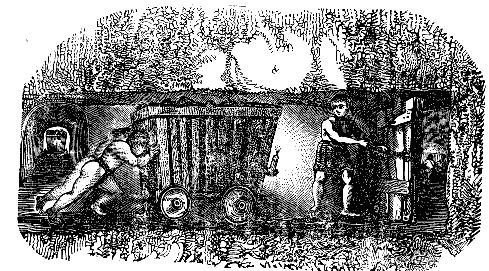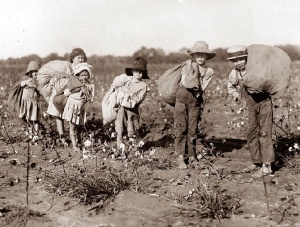The Forgotten Slaves: Whites in Servitude in Early America and Industrial Britain by Michael A. Hoffman II ©Copyright 1999. All Rights Reserved
White children enslaved in a mine in 19th century England. The two on the left are virtually naked. Children of both sexes worked in this manner.
~
Two years ago, Prime Minister Paul Keating of Australia refused to show “proper respect” to Britain’s Queen Elizabeth II during her state visit. In response, Terry Dicks, a Conservative member of the British Parliament said, “It’s a country of ex-convicts, so we should not be surprised by the rudeness of their prime minister.”
A slur such as this would be considered unthinkable if it were uttered against any other class or race of people except the descendants of White slavery. Dicks’ remark is not only offensive, it is ignorant and false. Most of Australia’s “convicts” were shipped into servitude for such “crimes” as stealing seven yards of lace, cutting trees on an aristocrat’s estate or poaching sheep to feed a starving family.
The arrogant disregard for the holocaust visited upon the poor and working class Whites of Britain by the aristocracy continues in our time because the history of that epoch has been almost completely extirpated from our collective memory.
When White servitude is acknowledged as having existed in America, it is almost always termed as temporary “indentured servitude” or part of the convict trade, which, after the Revolution of 1776, centered on Australia instead of America. The “convicts” transported to America under the 1723 Waltham Act, perhaps numbered 100,000.
The indentured servants who served a tidy little period of 4 to 7 years polishing the master’s silver and china and then taking their place in colonial high society, were a minuscule fraction of the great unsung hundreds of thousands of White slaves who were worked to death in this country from the early l7th century onward.
Up to one-half of all the arrivals in the American colonies were Whites slaves and they were America’s first slaves. These Whites were slaves for life, long before Blacks ever were. This slavery was even hereditary. White children born to White slaves were enslaved too.
Whites were auctioned on the block with children sold and separated from their parents and wives sold and separated from their husbands. Free Black property owners strutted the streets of northern and southern American cities while White slaves were worked to death in the sugar mills of Barbados and Jamaica and the plantations of Virginia.
The Establishment has created the misnomer of “indentured servitude” to explain away and minimize the fact of White slavery. But bound Whites in early America called themselves slaves. Nine-tenths of the White slavery in America was conducted without indentures of any kind but according to the so-called “custom of the country,” as it was known, which was lifetime slavery administered by the White slave merchants themselves.
In George Sandys laws for Virginia, Whites were enslaved “forever.” The service of Whites bound to Berkeley’s Hundred was deemed “perpetual.” These accounts have been policed out of the much touted “standard reference works” such as Abbott Emerson Smith’s laughable whitewash, Colonists in Bondage.
I challenge any researcher to study 17th century colonial America, sifting the documents, the jargon and the statutes on both sides of the Atlantic and one will discover that White slavery was a far more extensive operation than Black enslavement. It is when we come to the 18th century that one begins to encounter more “servitude” on the basis of a contract of indenture. But even in that period there was kidnapping of Anglo-Saxons into slavery as well as convict slavery.
In 1855, Frederic Law Olmsted, the landscape architect who designed New York’s Central Park, was in Alabama on a pleasure trip and saw bales of cotton being thrown from a considerable height into a cargo ship’s hold. The men tossing the bales somewhat recklessly into the hold were Negroes, the men in the hold were Irish.
Olmsted inquired about this to a shipworker. “Oh,” said the worker, “the niggers are worth too much to be risked here; if the Paddies are knocked overboard or get their backs broke, nobody loses anything.”
Before British slavers traveled to Africa’s western coast to buy Black slaves from African chieftains, they sold their own White working class kindred (“the surplus poor” as they were known) from the streets and towns of England, into slavery. Tens of thousands of these White slaves were kidnapped children. In fact the very origin of the word kidnapped is kid-nabbed, the stealing of White children for enslavement.
According to the English Dictionary of the Underworld, under the heading kidnapper is the following definition: “A stealer of human beings, esp. of children; originally for exportation to the plantations of North America.”
The center of the trade in child-slaves was in the port cities of Britain and Scotland:
“Press gangs in the hire of local merchants roamed the streets, seizing ‘by force such boys as seemed proper subjects for the slave trade.’ Children were driven in flocks through the town and confined for shipment in barns…So flagrant was the practice that people in the countryside about Aberdeen avoided bringing children into the city for fear they might be stolen; and so widespread was the collusion of merchants, shippers, suppliers and even magistrates that the man who exposed it was forced to recant and run out of town.” (Van der Zee, Bound Over, p. 210).
White slaves transported to the colonies suffered a staggering loss of life in the 17th and 18th century. During the voyage to America it was customary to keep the White slaves below deck for the entire nine to twelve week journey. A White slave would be confined to a hole not more than sixteen feet long, chained with 50 other men to a board, with padlocked collars around their necks. The weeks of confinement below deck in the ship’s stifling hold often resulted in outbreaks of contagious disease which would sweep through the “cargo” of White “freight” chained in the bowels of the ship.
Ships carrying White slaves to America often lost half their slaves to death. According to historian Sharon V. Salinger, “Scattered data reveal that the mortality for [White] servants at certain times equaled that for [Black] slaves in the ‘middle passage,’ and during other periods actually exceeded the death rate for [Black] slaves.” Salinger reports a death rate of ten to twenty percent over the entire 18th century for Black slaves on board ships enroute to America compared with a death rate of 25% for White slaves enroute to America.
Foster R. Dulles writing in Labor in America: A History, states that whether convicts, children ‘spirited’ from the countryside or political prisoners, White slaves “experienced discomforts and sufferings on their voyage across the Atlantic that paralleled the cruel hardships undergone by negro slaves on the notorious Middle Passage.”
Dulles says the Whites were “indiscriminately herded aboard the ‘white guineamen,’ often as many as 300 passengers on little vessels of not more than 200 tons burden–overcrowded, unsanitary…The mortality rate was sometimes as high as 50% and young children seldom survived the horrors of a voyage which might last anywhere from seven to twelve weeks.”
Independent investigator A.B. Ellis in the Argosy writes concerning the transport of White slaves, “The human cargo, many of whom were still tormented by unhealed wounds, could not all lie down at once without lying on each other. They were never suffered to go on deck. The hatchway was constantly watched by sentinels armed with hangers and blunder busses. In the dungeons below all was darkness, stench, lamentation, disease and death.”
Marcus Jernegan describes the greed of the shipmasters which led to horrendous loss of life for White slaves transported to America:
“The voyage over often repeated the horrors of the famous ‘middle passage’ of slavery fame. An average cargo was three hundred, but the shipmaster, for greater profit, would sometimes crowd as many as six hundred into a small vessel…The mortality under such circumstances was tremendous, sometimes more than half…Mittelberger (an eyewitness) says he saw thirty-two children thrown into the ocean during one voyage.”
“The mercantile firms, as importers of (White) servants, were not too careful about their treatment, as the more important purpose of the transaction was to get ships over to South Carolina which could carry local produce back to Europe. Consequently the Irish–as well as others–suffered greatly…
“It was almost as if the British merchants had redirected their vessels from the African coast to the Irish coast, with the white servants coming over in much the same fashion as the African slaves.” (Warren B. Smith, White Servitude in Colonial South Carolina).
A study of the middle passage of White slaves was included in a Parliamentary Petition of 1659. It reported that White slaves were locked below deck for two weeks while the slaveship was still in port. Once under way, they were “all the way locked up under decks…amongst horses.” They were chained from their legs to their necks.
Those academics who insist that slavery is an exclusively Black racial condition forget or deliberately omit the fact that the word slave originally was a reference to Whites of East European origin – “Slavs.”
Moreover, in the 18th century in Britain and America, the Industrial Revolution spawned the factory system whose first laborers were miserably oppressed White children as young as six years of age. They were locked in the factories for sixteen hours a day and mangled by the primitive machinery. Hands and arms were regularly ripped to pieces. Little girls often had their hair caught in the machinery and were scalped from their foreheads to the back of their necks.
White Children wounded and crippled in the factories were turned out without compensation of any kind and left to die of their injuries. Children late to work or who fell asleep were beaten with iron bars. Lest we imagine these horrors were limited to only the early years of the Industrial Revolution, eight and ten year old White children throughout America were hard at work in miserable factories and mines as late as 1920.
Because of the rank prostitution, stupidity and cowardice of America’s teachers and educational system, White youth are taught that Black slaves, Mexican peons and Chinese coolies built this country while the vast majority of the Whites lorded it over them with a lash in one hand and a mint julep in the other.
The documentary record tells a very different story, however. When White Congressman David Wilmot authored the Wilmot Proviso to keep Black slaves out of the American West he did so, he said, to preserve that vast expanse of territory for “the sons of toil, my own race and color.”
This is precisely what most White people in America were, “sons of toil,” performing backbreaking labor such as few of us today can envision. They had no paternalistic welfare system; no Freedman’s Bureau to coo sweet platitudes to them; no army of bleeding hearts to worry over their hardships. These Whites were the expendable frontline soldiers in the expansion of the American frontier. They won the country, felled the trees, cleared and planted the land.
The wealthy, educated White elite in America are the sick heirs of what Charles Dickens in Bleak House termed “telescopic philanthropy”–the concern for the condition of distant peoples while the plight of kindred in one’s own backyard are ignored.
Today much of what we see on “Turner Television” and Pat Robertson’s misnamed “Family Channel,” are TV films depicting Blacks in chains, Blacks being whipped, Blacks oppressed. Nowhere can we find a cinematic chronicle of the Whites who were beaten and killed in White slavery. Four-fifths of the White slaves sent to Britain’s sugar colonies in the West Indies did not survive their first year.
Soldiers in the American Revolution and sailors impressed into the American navy received upwards of two hundred whiplashes for minor infractions. But no TV show lifts the shirt of these White yeoman to reveal the scars on their backs.
The Establishment would rather weep over the poor persecuted Negroes, but leave the White working class “rednecks” and “crackers” (both of these terms of derision were first applied to White slaves), to live next door to the Blacks.
Little has changed since the early 1800s when the men of property and station of the English Parliament outlawed Black slavery throughout the Empire. While this Parliament was in session to enact this law, ragged five year old White orphan boys, beaten, starved and whipped, were being forced up the chimneys of the English parliament, to clean them. Sometimes the chimney masonry collapsed on these boys. Other times they suffocated to death inside their narrow smoke channels.
Long after Blacks were free throughout the British Empire, the British House of Lords refused to abolish chimney-sweeping by White children under the age of ten. The Lords contended that to do so would interfere with “property rights.” The lives of the White children were not worth a farthing and were considered no subject for humanitarian concern.
The chronicle of White slavery in America comprises the dustiest shelf in the darkest corner of suppressed American history. Should the truth about that epoch ever emerge into the public consciousness of Americans, the whole basis for the swindle of “Affirmative action,” “minority set-asides” and proposed “Reparations to African-Americans” will be swept away. The fact is, the White working people of this country owe no one. They are themselves the descendants, as Congressman Wilmot so aptly said, of “the sons of toil.”
There will only be racial peace when knowledge of radical historical truths are widespread and both sides negotiate from positions of strength and not from fantasies of White working class guilt and the uniqueness of Black suffering.
Let it be said, in many cases Blacks in slavery had it better than poor Whites in the antebellum South. This is why there was such strong resistance to the Confederacy in the poverty-stricken areas of the mountain south, such as Winston County in Alabama and the Beech mountains of North Carolina. Those poor Whites could not imagine why any White laborer would want to die for the slave-owning plutocracy that more often than not, gave better care and attention to their Black servants than they did to the free white labor they scorned as “trash.”
To this day, the White ruling class denigrates the White poor and patronizes Blacks.
If this seems admirable from the pathological viewpoint of Marxism or cosmopolitan liberalism, the Black and Third World “beneficiaries” of White ruling class “esteem” ought to consider what sort of “friends” they actually have.
The Bible declares that the man who does not take care of his own family is “worse than an infidel.” This also applies to one’s racial kindred. The man who neglects his own children to care for yours has true love for neither.
White, self-hating liberals and greed-head conservatives who claim to care for the “civil rights” of Black and Third World people, discard the working class of their own people on the garbage heap of history. When they are finished with their own they shall surely turn on others.
Those who care for their own kind first are not practicing “hate” but kindness, which is the very root of the word.







